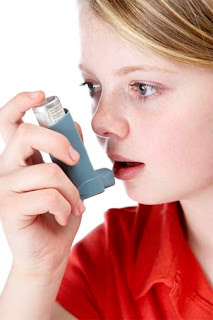 Nursing Care Plan for Asthma : Nanda Nursing Diagnosis and Interventions
Nursing Care Plan for Asthma : Nanda Nursing Diagnosis and Interventions1. Ineffective airway clearance related to airway spasm, secretion retention, amount of mucus.
Goal: The patient showed the ability to maintain the cleanliness of the airway, with the expected outcomes:
- There is no secret
- Lungs clear sound
1. Airway menagement:
- Free the airway (suction)
- Monitor the chest wall retraction
- Monitor respiration rate
- Give a semi-Fowler position
- Listen to lung sounds
- Encourage the patient to drink warm
- Do suction
- Monitor oxygen delivery
- Evaluation of lung sounds after suction
2. Ineffective breathing pattern related to spasm of the airway, respiratory muscle fatigue.
Goal: Adequate patient's respiratory status, with the result criteria:
- Respiration rate is within normal limits
- Not seen the use of additional respiratory muscles
- No complaints of pain in breathing
1. Airway management:
- Monitor respiratory patients
- Monitor the use of additional respiratory muscles (chest wall retraction)
- Monitor Vitas signs; respiration, pulse, blood pressure, temperature
- Position the patient in semi-Fowler position
- Provide oxygen according to program
- Give oxygen through a nasal or face mask canul
- The flow of 1-6 liters / minute oxygen concentration produces 24-44%
- The flow of 5-8 liters / minute oxygen concentration produces 40-60%
- The flow of 8-12 liters / min oxygen concentration produces 60-80%
- The flow of 8-12 liters / min oxygen concentration producing 90%
3.Impaired gas exchange related to bronchospasme, damage to the alveoli.
Goal: effective gas exchange, with expected outcomes:
- Free from symptoms of respiratory failure, cianosis, nostril breath
- Blood gas analysis results within normal limits.
1. Airway management:
- Position the patient in a position semifowler
- Auscultation of breath sounds of patients
- Patient's fluid balance
- Monitor respiration rate
- Clear the airway of secretions (Suction)
- Teach the client to use an inhaler
- Monitor blood gas analysis
- Monitor electrolyte levels
- Monitor oxygen saturation
- Collaboration of medication to maintain the acid-base balance (sodium bicarbonate)
- Monitor hemodynamic status
4. Activity intolerance related to imbalance of oxygen supplied to the needs
Goal: The patient showed tolerant state of activity, with the expected outcomes:
- No shortness of breath on exertion
- Able to move up
1. Energy management:
- Determine the causes of fatigue
- Monitor respiratory (respiration, dyspnoea, pallor)
- Help clients choose the activities that can be done
- Recommended to increase the intake of nutrients
5. Knowledge deficit: about asthma, related to lack of information sources.
Goal: increase patient knowledge about asthma, the expected outcomes:
- Knowing trigger asthma
- Knowing about the things that need to be avoided
- Knowing the handling of the attack.
1. Assess the things that have been known to patients
2. Assess the patient's condition before health education, do not provide health education, while patients in the state of attack.
3. Education:
- Explain the meaning of asthma
- Explain the trigger factor
- Describe the things that need to be avoided: elergan factors, stress, excessive cold weather activity
- Explain how the handler during an asthma attack at home
- Evaluate what has been delivered.
6. Anxiety related to crisis situations: changes in health status
Goal: The patient can control anxiety and increase coping, with expected outcomes:
- Patient's expression relaxed
- Vital signs are within normal limits
1. Lower levels of anxiety:
- Listen to their patients
- Explain each will perform maintenance procedures
- Instruct the patient to accompany the family as a support system during an asthma attack
- Turning his attention upward
- Respiratory control by drawing a deep breath (relaxation)
- Position your body relax
- Make a relaxed mood, relaxed facial expression.
7. Imbalanced Nutrition, Less Than Body Requirements related to an increase in shortness of breath, intolerance to activity
Goal: Nutrition clients adequate, with expected outcomes:
- Increased oral input
1. Environmental Management:
- Provide a relaxed dining atmosphere
- Limit visitors during mealtimes
- Assess the client's food preferences and diet recommended
- Monitor oral intake, if not enough add parenteral nutrition
- Anjurrkan eat small meals but often
- Anjurrkan for clients favorite meals
- Collaboration with the nutrition.